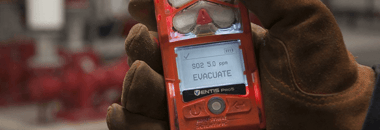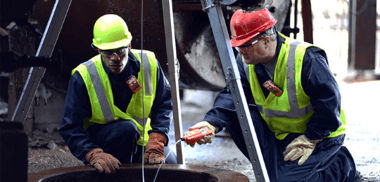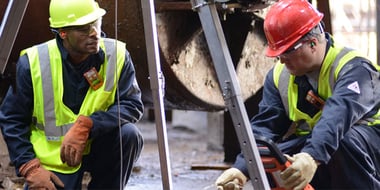Confined spaces can be extremely dangerous—low oxygen levels, combustible gases, and toxic substances are just a few of the threats your workers may encounter within a confined space. Despite awareness, regulation, and technological advancements, confined space injuries and fatalities continue to occur. According to the National Safety Council, in a 2020 survey 13% of workers reported that a confined space entry had caused or contributed to a serious workplace injury at their facility.
The steps to working safely in a confined space begin before workers even enter the space. By understanding confined space regulations, obtaining permits, gearing up, and testing the atmosphere before entering a confined space, you can prevent serious injury or even death.
Confined Space Gas Sampling Basics
Confined space entry regulations require that the atmosphere is tested and cleared of hazards prior to a worker entering the space. This is where remote sampling comes in to ensure that oxygen and hazardous gas levels are within safe limits.
The first step you should consider is your approach to the confined space. After you’ve checked and prepared your sampling accessories and pump equipment, you should sample the atmosphere from a safe location. For example, you may want to stand upwind or off to the side of the entrance—you don’t want to be in the direct flow of any gas that could be escaping or evacuating from the space.
Once you’ve safely approached the confined space and you’ve begun taking samples, you must consider factors like stratification of gases.
What are Gas Stratification Patterns in Confined Spaces?
Gas stratification in confined spaces is the way different gases settle in a space based on their weight in relation to air. The toxic gases that you may commonly encounter in confined spaces have a typical stratification pattern. For example, hydrogen sulfide (H2S) settles at the bottom—it’s a heavier-than-air gas. Carbone monoxide (CO), which is slightly lighter than air, tends to settle in the middle, while methane sits on top.
However, these are not absolute rules. You also need to take into consideration things like air current or ventilation that may impact the way gases settle. For example, if your gas monitor reads H2S closer to the top of the confined space, it’s not necessarily incorrect. Remember, these are general guidelines, and for more specific information concerning confined space entry, consult your regulatory agencies for details.
Four-Foot Rule for Remote Sampling
Because of the way gases tend to separate and settle, you should follow the four-foot rule when remote sampling to make sure you don’t miss any potential hazards. The four-foot rule is simple: sample the levels or intervals approximately every four feet through the entire depth of your space. If your space happens to be smaller than twelve feet deep, sampling at the top, middle, and bottom will cover most of your areas.
The Importance of Filtration
When entering a confined space, using filters with your gas monitoring equipment is crucial to protect it from contamination. Filters must be installed in your pumped gas detector and at the end of your sampling path. The end of your sampling lines can be protected using replaceable disc-style filters.
Let’s walk through an example that illustrates the importance of filters. A worker is in the field and drops a line into a confined space vessel. The line has a filter on the end of it, and that filter pulls in a contaminant—so what does the worker do next? Removes the filter and continues sampling. Then, the sampling line becomes contaminated, and it leads back to the filter in the equipment.
Finally, they remove the filter from the pump, and ultimately the inside of the pump is contaminated. Replacing a filter is much more affordable than replacing a gas detector. Always use filtration when you are sampling confined spaces!
Inspecting and Testing Your Remote Sampling Equipment
Before inspecting and testing your sampling accessories and pump, you must conduct the four steps of safe operation using a DSX Docking Station or similar. You can also perform the steps using your manual calibration and bump testing equipment. Let’s quickly review those four steps.
With a docking station:
-
- Dock the gas detector to charge it, bump test it, and calibrate it if needed. After it’s finished, the light on the dock will turn green.
- Turn on the instrument and check the battery.
- Conduct a zero in a clean and safe atmosphere.
- Clear the peaks.
Without a docking station:
-
- Power on the instrument and check the battery.
- Zero the gas detector in a clean and safe atmosphere.
- Conduct your bump test.
- Clear the peaks.
Once the four steps of operation are complete and your gas detector is ready for use, you can move on to the inspection and the test.
The first thing to do is check your gas detector and make sure that your filters are in good condition. Unscrew the cap to verify that the filter is in clean. The only time you need to replace the filter is when it’s either contaminated or damaged.
Next, inspect the probe you plan to use for your remote sampling. Double check that there are no breaks in your sampling path. With an extendable probe with a filter installed, extend the probe, cover the ends with your fingers, and collapse it to check that each of the seals are intact. When you collapse the probe and release one of your fingers, you should hear air escape. If you do, your probe is good.
In the next step, include the coiled tubing. The probe will attach to the tubing and the pump. You need to ensure that the tubing is also complete and in good condition. Connect the tubing to the end of the probe and conduct the same test you just completed. This time, pinching the end of the tubing and collapsing the probe. If you hear air escaping when you release your finger from the end of the probe, your sampling path is intact.
In the final test, you need to ensure the pump goes into an overrun condition. This verifies the presence of blockage in your sampling path during normal operation. The gas detector will notify you by shutting the pump off and alarming.
To test this functionality, attach the pump to the end of your tubing, and when you finally block it, the pump should indicate a stoppage with visual, audible, and vibrating alarms. The instrument will pause for a few seconds, wait to see if the blockage has cleared and then restart. If the alarm condition clears, it your gas detector will return to normal operation, and you can begin your confined space entry. If the alarm returns, investigate the blockage and do NOT use your sampling equipment and gas detector until you can clear the alarm and verify proper operation.
What is the Two-by-Two Rule in Confined Spaces?
The final step of remote sampling is knowing and applying the “two-by-two rule.” The two-by-two rule states that for every foot of tubing, you allow two seconds for the gas to pass through every foot of length of tubing, plus two minutes at each location.
For example, if you have 10 feet of tubing, you need to wait approximately 20 seconds for the gas to pass through the sampling tube to get to the instrument. At that point, the sensors will begin to respond and shortly thereafter you will begin to see those gas readings. Once they appear, you need give the detector two additional minutes at that location to get the full concentration of gas according to the two-by-two rule. This results in a sample time of approximately 2:20.
Repeat this process every four feet within the confined space to ensure the atmosphere is clear of gas hazards and safe to enter. Additional checks should be conducted in the same manner as you move throughout the space entering different areas if it is a larger vessel with multiple areas.
When it comes to confined space entry and stratification of gasses, always err on the side of safety and follow your remote sampling fundamentals to keep yourself and your team safe.
For additional information regarding confined space entry, download our guide for detecting gas hazards in confined spaces.




